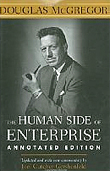 In this post we continue to explore “The Assumptions of Theory Y,” provided by Douglas McGregor in his seminal book, The Human Side of Enterprise.
In this post we continue to explore “The Assumptions of Theory Y,” provided by Douglas McGregor in his seminal book, The Human Side of Enterprise.
Assumption 2: External control and the threat of punishment are not the only means for bringing about effort toward organizational objectives. Man (woman) will exercise self-direction and self-control in the service of objectives to which he (she) is committed.
The act of “committing” typically involves agreeing or pledging to do something in the future and also implies a state of being obligated or emotionally impelled, as in commitment to a cause. In a work setting it is easier to be committed to tasks and assignments that align with our values and/or require our strengths, gifts and talents.
For example, if a core value is service to others and the company produces assistive technology, there would seem to be an alignment at some level with core values. If your natural gift and talent is connecting people, and you are asked to be the community liason, there may be a high level of commitment in that assignment.
Another way to look at commitment is how fully you are able to “show up,” with 100% representing full commitment. In a strong collaborative work environment, ideally every team member is showing up 100%, fully committed to the task at hand. At 100% commitment among all employees, we may assume there is maximum productive effort toward organizational objectives (assuming they are clearly defined).
When commitment is low, the question to explore is “Where is the disconnect and/or misalignment?” and “How can I see and/or reframe this situation to be more fully committed?” In this way, finding connections between what matters to us on a personal level with the organizational objectives, creates a natural state of alignment which promotes commitment. It makes sense that people would be motivated to act in service of objectives to which they can align to.
Sometimes the connections are not obvious and it takes deeper probing to see the links. Sometimes there is a disconnect between what the company is focusing on and what the market needs. Sometimes, lack of alignment (clear vision and clear roles) is the bottom line issue.
THINK ABOUT
- Where do you feel the greatest amount of commitment in your work? …the least amount of commitment?
- What are your core values and how well do they align with the outcomes of your organization and/or your work?
- Where may there be disconnects and/or misalignment that keep you from being fully committed.
- How might you see and/or reframe the situation so you may be more fully committed?
by Jackie Levin



 Posted by mindfulinnovation
Posted by mindfulinnovation 
